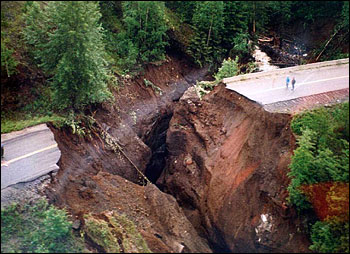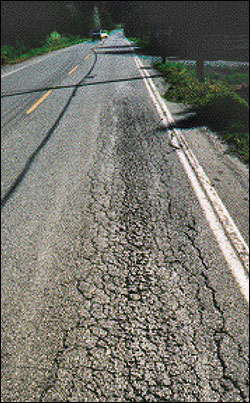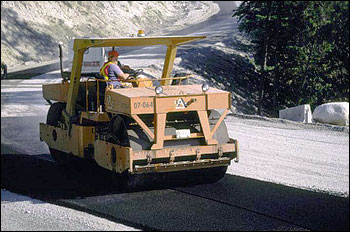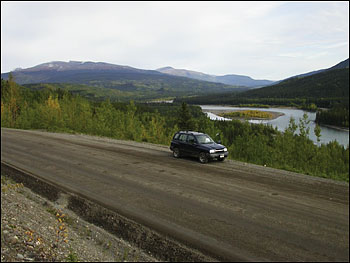 |
Goal 1: B.C. is provided with a safe and reliable highway system.
Core Business Area: Highway Operations
Objective: The provincial highway system is maintained to a high standard through the efficient and effective administration of road and bridge maintenance contracts.
Key strategy: Implement the Contractor Assessment Program, a new and improved procedure for auditing the delivery of contracted highway maintenance activities.
| Performance Measure |
2001/02 Actual |
2002/03 Actual |
2003/04 Target |
2003/04 Actual |
2003/04 Variance |
Contractor Assessment Program:
Rating of the maintenance contractors' performance with a maximum score of 1 |
0.91 |
0.92 |
0.91 |
0.92 |
0.01 |
| Linkage to goal and objective |
| The Contractor Assessment Program measures the performance of road and bridge maintenance contractors. The program examines how well contractors are meeting the standards set out in maintenance contracts. The results are reviewed regularly to ensure highway users receive good value and service that contributes to a safe and reliable highway system. |
| Descriptive information |
| The ministry bases its assessments of contractors on input from the district, the region and local stakeholders. The district input is based on results of random audits conducted to verify compliance with the contract terms. Regional audits are also conducted to ensure objectivity and consistency across the province. Finally, local stakeholders such as the RCMP, emergency response providers, school bus district coordinators and local industry representatives are asked to rate their levels of satisfaction with road maintenance activities such as winter maintenance and surface maintenance (patching, grading), as well as whether the contractors are dealing with customer complaints in a professional manner. The assessments show that overall the maintenance contractors' compliance with standards has been consistently good. |
| Factors impacting results |
The audit process has been developed in consultation with ministry staff, the maintenance contracting industry and external experts in the field. However, it is an entirely new program. Actual functioning and ratings will need to be reviewed at the end of the first year of operation, to determine actual program response versus predicted response, and to make adjustments accordingly.
Stakeholder assessments require an education process regarding maintenance contractor responsibilities, and stakeholders may not fully be aware of, or may misinterpret, the terms of the contract, which may cause the results to be inaccurate. Also, the standard set of questions posed to stakeholders to obtain an assessment of how well their needs are being met by the contractor may not address all areas of performance, which may also affect the results. At the end of each season, the ministry's District Operations Managers meet with key stakeholders in each contract area to ensure that the terms of the contract are understood. |
Key strategy: By October 2004, tender and award all road and bridge maintenance contracts under the process established in 2002/03.
| Performance Measure |
2001/02 Actual |
2002/03 Actual |
2003/04 Target |
2003/04 Actual |
2003/04 Variance |
| Maintenance cost per lane kilometre |
$4,124 |
$4,159 |
$4,170 |
$4,090 |
$80 |
| Linkage to goal and objective |
| The cost per lane kilometre shows how well the ministry is containing costs in the maintenance program, which uses a substantial portion of the ministry budget ($346 million in 2003/04). The ministry targets to efficiently allocate resources to get the maximum output. |
| Descriptive information |
| Maintenance cost figures include the cost of road and bridge maintenance contracts and an estimate of other maintenance activities performed by ministry staff. Actual results are calculated by dividing the total allocated cost by the total number of lane kilometres of road maintained (84,624 kilometres in 2003/04). |
| Factors impacting results |
| The number of lane kilometres maintained, which is used to calculate cost figures, is influenced by changes in the ministry's road inventory. For example the devolution of infrastructure, incorporations and the extension of municipal boundaries would result in fewer kilometres for the ministry to maintain. The costs of materials also have a direct effect on the cost figures. The increase in costs in 2002/03 was due mostly to inflation and especially to an increase in the cost of fuel. The positive variance in 2003/04 was a result of savings from recently-awarded maintenance contracts. |
Key strategy: Continue to take both proactive and responsive approaches to minimize unplanned lane closures.
| Performance Measure |
2003/04 Target |
2003/04 Actual |
2003/04 Variance |
| Annual total duration of unplanned highway closures greater than 1/2 hour for all numbered highways |
2,500 hours |
3,723 hours |
(1,223 hours) |
| Linkage to goal and objective |
| The reliability of a highway can be measured by the probability that the road will be open and usable when the public wishes to travel or move goods over it. The ministry strives to keep lanes open as much as possible and to provide adequate advance notification of closures to travellers. |
| Descriptive information |
| Lane closures may be planned; for example, when maintenance activities could pose a hazard to road users; or unplanned as a result of natural causes or motor vehicle accidents. The ministry collects data about highway closures of all kinds at the Provincial Highways Condition Centre to measure the level of reliability being delivered to road users. The 2003/04 target is based on past unplanned highway closures. Targets and actual results are measured by the calendar year, so 2003/04 actually encompasses January to December 2003. |
| Factors impacting results |

Flood and slide damage
|
Many closures are unplanned, and their frequency varies from year to year. Unplanned closures may be due to traffic accidents or weather, and are largely outside the ministry's control. Most of the unfavorable variance in 2003/04 was due to closures caused by forest fires (1,191 hours in 2003). The ministry analyzes closures data to develop ways to minimize or mitigate future closures and to develop rapid recovery strategies, such as being responsive (e.g., through clearance of debris and collisions), being proactive (e.g., through rock scaling and planned avalanches), working with police to minimize the duration of closures after accidents and making physical improvements to the highway system. |
Objective: B.C.'s main highways are preserved in their current condition — that is, not allowed to deteriorate.
Key strategy: Regularly assess the condition of the main highways.
| Performance Measures |
2001/02 Actual |
2002/03 Actual |
2003/04 Target |
2003/04 Actual |
2003/04 Variance |
Pavement condition for main highways:
Per cent of kilometres where condition is good or excellent |
76% |
75% |
76% |
76% |
— |
Bridge condition:
Per cent of bridges where condition is good or excellent |
81% |
82% |
80% |
85% |
5% |
| Linkage to goal and objective |
| Deteriorating roads lead to increased costs for people who use the roads and taxpayers who fund them. Road users experience costly delays, vehicle damage, cargo damage and greater risks of accident. Roads, once allowed to deteriorate, cost the taxpayer far more to restore than if they had been kept in satisfactory condition in the first place. The value of highway investments can be increased by extending the useful life of pavements and bridges. |
| Descriptive information |

Impact of not investing
|
 |
The ministry measures pavement performance in terms of surface distress and pavement roughness. Surface distress is a true engineering measure of the pavement deterioration, while pavement roughness measures the riding comfort of the road user. Combined, both types of information provide a Pavement Condition Rating, which the ministry uses to determine rehabilitation needs. The ministry uses sophisticated methods to monitor pavement condition, and to develop timely rehabilitation strategies, through surveys conducted by contractors. The use of a third party contractor to collect the data provides objectivity and consistency throughout the province. The surveys and data processing are guided by quality assurance procedures to ensure the data is collected accurately and is repeatable from year to year.
The Bridge Condition Index (BCI) is a measure of the average condition of a bridge and its components. The BCI is based on the condition indices for each component type used on a particular structure. Factors affecting bridge performance are related to condition as well as function, and are addressed in the rehabilitation program.
Measures that involve monitoring the physical condition of the highways are widely used and accepted in many Transportation agencies. |
|
| Factors impacting results |
| Transportation infrastructure of all kinds deteriorates over time with wear and tear from usage and the effects of weather. Postponing rehabilitation until the road is in poor condition can increase costs up to several times what they would have been if it had been fixed earlier. Meeting the established targets is dependent on budget allocations and prioritization. Since 2001/02, the percentage of pavement in good or excellent condition has remained constant, reflecting the ministry's funding strategy to hold the current condition and prevent any onset of deterioration. The positive variance in bridge condition is due to the addition of new bridges through other programs, resulting in an overall increase of bridges in good condition. |
Key strategy: Rehabilitate the main highways according to the ministry's long-term strategy and using the most cost-effective methods.
| Performance Measure |
2001/02 Actual |
2002/03 Actual |
2003/04 Target |
2003/04 Actual |
2003/04 Variance |
| Number of lane kilometres resurfaced (improved) |
2,180 km |
2,165 km |
2,500 km |
2,794 km |
294 km, or 12% |
| Linkage to goal and objective |
| B.C.'s provincial highway network is "mature" in that most highways have already been in place for some time. Rehabilitation restores roads and bridges to their original condition and extends their useful lives at minimal cost if it is done before deterioration has progressed too far. Rehabilitation needs must be met every year if the highway system is to continue to support economic development and community growth, and is required for all highways to keep them operational, safe and reliable. |
| Descriptive information |
| The number of lane kilometres surfaced will include all roadways that are resurfaced within a fiscal year. Typical resurfacing treatments include asphalt overlays, hot-in-place recycling, milling, reclamation, micro-surfacing, sealcoat applications and first time hard surfacing of gravel roads. Lane kilometres of resurfacing are physically measured in the field during resurfacing projects, and are calculated by summing the total lengths of individual travel lanes that are resurfaced. For example, 15 kilometres of two-lane highway would equal 30 total lane kilometres. |
| Factors impacting results |
|

A compaction roller compacting freshly laid asphalt.
|
Meeting established targets depends on the availability of funding. Targets can be missed as a result of unforeseen circumstances such as harsh winter conditions, spring freeze-thaw, slides and flooding. The 2003/04 target of 2,500 km was established in anticipation of additional resurfacing and first time hard-surfacing undertaken as part of the Ministry's Heartlands program. The additional kilometres achieved in 2003/04 is attributed to less expensive sealcoats done on side roads under the Heartlands Program, and also a result of conscious program delivery; monitoring and effective risk management which allowed timely decisions capitalizing on the construction season. |
Objective: Improved road access for resource industries and rural residents.
Key strategy: Increase annual investment in northern and Heartlands road reconstruction by $75 million in 2003/04 through 2005/06.
| Performance Measures |
2002/03 Actual |
2003/04 Target |
2003/04 Actual |
2003/04 Variance |
Surface condition:
Per cent of kilometres where condition is good or excellent |
34% |
37% |
39% |
2% |
| Number of lane kilometres treated |
N/A |
870 km |
894 km |
24 km |
| Linkage to goal and objective |

Skeena Highway |
 |
Heartlands roads provide vital links to communities and resource industries. These roads have deteriorated in the last decade because of a shortage of funding for maintenance and rehabilitation. A substantial increase in investment to $75 million per year will yield significant improvements. The ministry will invest strategically to support resource industries and ensure the safety and reliability of these roads.
|
|
| Descriptive information |
Independent contractors will assess the road surface conditions and measure surface distress and roughness for paved surfaces. Surface condition data is collected and representative sampling is used to measure results. The pavement data is collected using very specialized vehicles equipped with sophisticated monitoring equipment, proven survey methodology and stringent quality control assurance specifications. Gravel surfaces are measured on a sampling basis.
Lane kilometres will be improved through treatments such as base reconstruction and strengthening, gravel surfacing, first time hard surfacing or resurfacing. The number of lane kilometres treated is measured in the field during program delivery.
|
| Factors impacting results |
| An additional 24 kilometres were treated due to changes of treatment and clustering of contracts which resulted in cost-effectiveness. In the north, more gravelling of roads than planned was undertaken and in the rural South Coast, first time hard surfacing was undertaken. |
Objective: Improved highway safety.
Key strategy: Monitor highway safety and implement corrective measures in high-risk locations, in consultation with regional transportation advisory committees.
| Performance Measures |
2003/04 Target |
2003/04 Actual |
Variance |
| Number of kilometres of rumble strip installed |
230 km |
303 km |
73 km or 32% |
| Number of kilometres of new guardrail installed |
13 km |
12.5 km |
(0.5) km or (4%) |
| Linkage to goal and objective |
| Roadside accidents account for a significant portion of all accidents occurring on provincial highways. Motor vehicles running off the road account for about one-third of all traffic fatalities province-wide. Safety studies suggest that 40 to 60 per cent of these crashes are due to driver fatigue or inattention. Safety reviews have shown that the installation of rumble strips and guardrail are proven preventative measures, which are effective at reducing the overall crash rate, as well as the number of serious injury accidents. |
| Descriptive information |
| Rumble strips are installed along stretches of highway to warn drivers and prevent them from leaving the road. Guardrail is a barrier used to shield motorists leaving the road from contact with natural or man-made obstacles. Through the use of both the ministry's roadside Guardrail Warrant Index System for Highways and the Highway Accident System, the ministry has developed a reliable program to rank provincial highway segments including specific locations for barrier and rumble strip installation. |
| Factors impacting results |
The availability of funding in the pavement rehabilitation program enabled the ministry to install more rumble strips than originally planned.
Shoulder base highway improvements required a higher cost per unit of guardrail than expected. The target did not reflect this higher cost, which resulted in the slightly unfavourable variance.
Many factors outside the ministry's control, such as bad weather or driver inattentiveness, can lead to fatalities or injuries. However, highway safety improvements can reduce the severity of accidents that may result.
|
|
|
